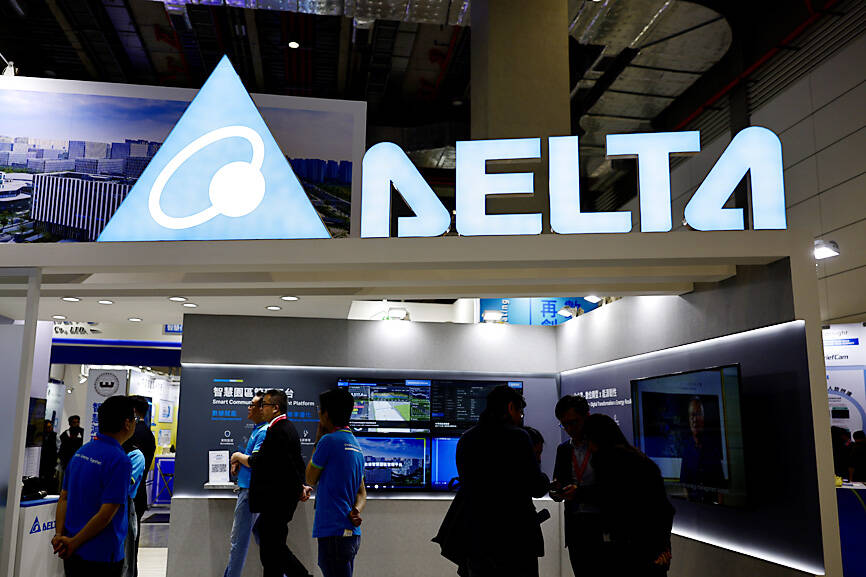Power supply and electronic component maker Delta Electronics Inc (台達電) on Wednesday reported revenue of NT$42.2 billion (US$1.44 billion) for last month, up 21.2 percent year-on-year and 2.8 percent month-on-month, driven by rising demand for power and heat dissipation products from artificial intelligence (AI) server customers.
Second-quarter sales reached NT$124.04 billion, a record high for a single quarter, it said. That represented an increase of 19.92 percent annually and 4.2 percent quarterly.
Delta attributed last quarter’s robust results to front-loaded orders ahead of US President Donald Trump’s planned tariffs on Taiwanese goods.

Photo: Ritchie B. Tongo, EPA-EFE
It also came from strong demand from AI data centers for power systems and liquid cooling solutions, a Delta official told the Taipei Times by telephone yesterday.
Cumulative revenue in the first half of this year rose 24.76 percent year-on-year to NT$242.95 billion, also the highest for the period, the company said.
Delta is working on heat dissipation components for Nvidia Corp’s GB300 servers in close collaboration with customers, and shipments of its advanced liquid cooling products have remained stable so far this year, said the official, who declined to be named.
However, a weaker greenback has slightly affected the company’s sales, as most of its receivables are denominated in US dollars, the official said.
Delta has continued to adopt a natural hedging strategy to mitigate the impact, and the company would disclose foreign-exchange losses at its second-quarter earnings conference on July 31, the official added.
The company’s Thai unit, Delta Electronics (Thailand) PCL, is building five new factories in the Southeast Asian nation, with construction proceeding as scheduled, the official said.
The timeline for mass production at the new factories would depend on customer demand and operational plans, the official said.
Thailand is Delta’s second-largest overseas production site after China.
Delta earlier this month acquired manufacturing facilities in Taoyuan’s Guanyin District (觀音) for NT$6.95 billion, which it plans to use for producing hydrogen energy, power storage and data center-related products, the official said.

IN THE AIR: While most companies said they were committed to North American operations, some added that production and costs would depend on the outcome of a US trade probe Leading local contract electronics makers Wistron Corp (緯創), Quanta Computer Inc (廣達), Inventec Corp (英業達) and Compal Electronics Inc (仁寶) are to maintain their North American expansion plans, despite Washington’s 20 percent tariff on Taiwanese goods. Wistron said it has long maintained a presence in the US, while distributing production across Taiwan, North America, Southeast Asia and Europe. The company is in talks with customers to align capacity with their site preferences, a company official told the Taipei Times by telephone on Friday. The company is still in talks with clients over who would bear the tariff costs, with the outcome pending further

WEAKER ACTIVITY: The sharpest deterioration was seen in the electronics and optical components sector, with the production index falling 13.2 points to 44.5 Taiwan’s manufacturing sector last month contracted for a second consecutive month, with the purchasing managers’ index (PMI) slipping to 48, reflecting ongoing caution over trade uncertainties, the Chung-Hua Institution for Economic Research (CIER, 中華經濟研究院) said yesterday. The decline reflects growing caution among companies amid uncertainty surrounding US tariffs, semiconductor duties and automotive import levies, and it is also likely linked to fading front-loading activity, CIER president Lien Hsien-ming (連賢明) said. “Some clients have started shifting orders to Southeast Asian countries where tariff regimes are already clear,” Lien told a news conference. Firms across the supply chain are also lowering stock levels to mitigate

NEGOTIATIONS: Semiconductors play an outsized role in Taiwan’s industrial and economic development and are a major driver of the Taiwan-US trade imbalance With US President Donald Trump threatening to impose tariffs on semiconductors, Taiwan is expected to face a significant challenge, as information and communications technology (ICT) products account for more than 70 percent of its exports to the US, Chung-Hua Institution for Economic Research (CIER, 中華經濟研究院) president Lien Hsien-ming (連賢明) said on Friday. Compared with other countries, semiconductors play a disproportionately large role in Taiwan’s industrial and economic development, Lien said. As the sixth-largest contributor to the US trade deficit, Taiwan recorded a US$73.9 billion trade surplus with the US last year — up from US$47.8 billion in 2023 — driven by strong

RESHAPING COMMERCE: Major industrialized economies accepted 15 percent duties on their products, while charges on items from Mexico, Canada and China are even bigger US President Donald Trump has unveiled a slew of new tariffs that boosted the average US rate on goods from across the world, forging ahead with his turbulent effort to reshape international commerce. The baseline rates for many trading partners remain unchanged at 10 percent from the duties Trump imposed in April, easing the worst fears of investors after the president had previously said they could double. Yet his move to raise tariffs on some Canadian goods to 35 percent threatens to inject fresh tensions into an already strained relationship, while nations such as Switzerland and New Zealand also saw increased